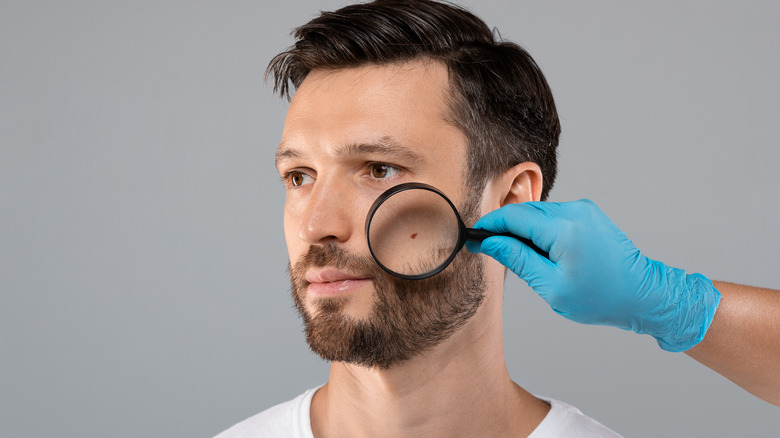What Causes A Random Bump On Your Head?
The head is a complex part of the human body that not only serves as a distinguishing external feature, but also houses the brain and most of the sensory organs (via Ken Hub). In order to support these vital structures, the human head is made in such a way that almost every inch is covered with intricate muscles and a complex network of blood vessels and nerves, all hidden under the skin. The muscles are responsible for any type of movement, such as chewing, making facial expressions, and blinking. On the other hand, the blood vessels supply oxygen and other nutrients to the head, and the nerves allow us to feel pain and other sensations, as well as facilitate signal transmissions within, to, and from the brain.
Like other parts of the body, the head is covered with skin, the first of the scalp's five distinct layers (per Medscape). Within these layers lie numerous hair follicles and sebaceous glands. Sebaceous glands are attached to the hair follicles and secrete an oily substance called sebum. Below the skin are several other layers of specialized connective tissues, where the muscles, nerves, and blood vessels can be found. Underneath all of this is the skull.
Most bumps that are felt on the head typically arise within the layers of the skin or just directly below it, as any growth underneath the skull will not be felt due to it being a very rigid structure. Here are some things that can cause random bumps on your head.
Physical trauma
One of the most common reasons why you would feel a random bump in your head is direct physical trauma. As Mayo Clinic explains, because the head has a rich blood supply and the skin does not provide much protection against mechanical damage, trauma can cause the blood vessels underneath the skin to tear. This leads to bleeding and pooling of blood in a localized area. On the outside, this appears as swelling and bruising. The bump forms towards the skin surface because the skin is elastic and able to stretch, while the skull is rigid and inflexible.
Johns Hopkins Medicine warns that although head injuries can be mild, they can also be life-threatening. They are a common cause of death and disability, especially if not treated properly. Whenever there is trauma to the head, not only can the blood vessels between the scalp and skull get damaged, but the brain also gets shaken inside the skull. Depending on the type and degree of trauma, the skull can also get fractured, or bleeding may occur within it. Intracranial bleeding is particularly dangerous, because the only way to detect it is through imaging.
Signs and symptoms of mild head injuries include localized swelling, bruising, headache, nausea, light sensitivity, irritability, and fatigue. Meanwhile, moderate to severe head injuries can result in loss of consciousness, slurred speech, persistent nausea and vomiting, severe headache, and short-term memory loss. While mild injuries typically resolve on their own, a severe head injury requires immediate medical attention.
Lipoma
According to Cleveland Clinic, a lipoma is a localized collection of fat cells that typically forms under the skin. They are very common, especially in adults between 40 to 60 years old. You may get concerned when you see them (or any other new bump, for that matter), but they are not cancerous. They grow very slowly or stay the same size indefinitely, and are typically not painful. They are oval- or round-shaped, soft and smooth, have a rubbery consistency, and can easily be moved around under the skin. They can be found almost everywhere, but it is more common to find them on the forehead, neck, shoulders, torso, arms, and legs. Unfortunately, there is no way to prevent lipomas from forming.
No one really knows why lipomas develop. It could be genetic, or a consequence of some form of injury. Your doctor will be able to easily tell if a lump is a lipoma or not, but if they are even mildly suspicious that it could be something else, they can have the lump biopsied to make sure that it is nothing more serious. Treatment is usually not necessary, but it can be removed surgically if it is bothering you (per DermNet).
Healthline adds that although the cause is unknown, there are certain diseases and syndromes that can increase your risk of developing lipomas. These include obesity, diabetes, liver disease, alcohol use disorder, Bannayan-Riley-Ruvalcaba syndrome, Cowden syndrome, Dercum's disease, Gardner's syndrome, and Madelung's disease.
Epidermoid cyst
A cyst is a collection of fluid encapsulated in a sac. They can form virtually anywhere in the body, including under the skin surface and even within internal organs. Cysts in the skin, breast, ovaries, and kidneys are the most common, and just like lipomas, they grow slowly and are not cancerous. Per Harvard Health, skin cysts can be epidermoid cysts or sebaceous cysts. Epidermoid cysts develop from superficial skin cells that migrate to deeper skin layers and form a sac that gets filled with keratin. On the other hand, sebaceous cysts develop when sebum gets trapped in the sebaceous gland and cannot be excreted. Skin cysts are typically painless, but they can become infected or cause inflammation if they rupture.
Although cysts can be left alone, they can also be removed for symptomatic relief or cosmetic reasons. This can be done by injecting medicine directly into the cyst, making a small cut and draining the fluid in the cyst, or opting to have it surgically removed. In very rare instances, they can lead to skin cancer (via Mayo Clinic).
Sebaceous cysts are a type of dermoid cyst that form in the deeper layers of the skin called the dermis. Aside from sebum, dermoid cysts may also contain hair and teeth. These commonly develop on the head, especially on the forehead, behind the ears, and the anterior fontanelle (i.e., soft spot on the head) in babies and young children (per Dartmouth Health Children's).
Pilar cyst
Pilar cysts (i.e., trichilemmal cysts) are the most common type of skin cysts, and they primarily affect the scalp. According to StatPearls, they typically develop spontaneously, although they grow very slowly. They are known to run in families, and they are more often seen in women than in men. Similar to epidermoid cysts, pilar cysts are filled with keratin, grow in areas with many hair follicles, and appear as smooth, skin-colored, firm nodules that are easily moveable. It is also pretty common to see more than one lesion at a time. Symptoms are usually nonexistent, unless the cyst ruptures or causes pressure over the bones. There is typically no need to do any imaging to diagnose pilar cysts, but if there is concern that the cyst is causing any damage to nearby structures, a CT scan may be done to evaluate for any bony invasion. If the bone is involved, an MRI will be able to detect if the underlying soft tissues are affected as well.
Pilar cysts are treated via surgical removal. Once removed, the lesion will be sent for analysis to make sure that it is in fact a cyst and not cancer. Because pilar cysts are hereditary, there is really no way to prevent them from developing. The most that you can do is actively and routinely check for any new growths and have them removed by your doctor if necessary (via Cleveland Clinic).
Acne
Although acne commonly appears on the face, they can develop on the scalp as well. Unlike lipomas and cysts, pimples are usually itchy and painful. They form as a consequence of clogged pores or hair follicles, which are abundantly found on the face and scalp. Per Cleveland Clinic, scalp acne is not common, but there are certain practices that can increase your risk of developing it. These include wearing hats or other types of headgear frequently, working in environments where you are exposed to oil or grease (e.g., cooks stationed in kitchen fryers), and using oil-based hair products. These practices can clog your pores with oil, sweat, dead skin cells, and product buildup, leading to the growth of microorganisms and subsequent infection and inflammation. Genetics, stress, hormone imbalances, and reactions to certain medications and food can also predispose you to developing scalp acne.
According to Medical News Today, acne on the scalp appears as small bumps along the hairline, whiteheads, closely packed bumps, or painful bumps on the scalp. They can be treated using topical or oral medications such as salicylic acid, glycolic acid, benzoyl peroxide, antimicrobials (e.g., ketoconazole, ciclopirox), steroids, and retinoids. Phototherapy can also sometimes be used. To help prevent scalp acne from developing, you should avoid wearing tight-fitting headgear, using too many hair products, and not washing your hair after working out or sweating. Since food can also be a trigger, it may help to keep a food diary so that you can keep track of which ones to avoid.
Folliculitis
Folliculitis is like acne, but worse. It is a condition wherein hair follicles get damaged, causing them to become inflamed and prone to infection (via Healthline). Although bacteria or fungi are involved, folliculitis is not contagious. It begins similarly to acne, where tiny red lesions can be seen on the skin, but in folliculitis, these painful and itchy lesions can get bigger and spread to other follicles. Hair follicles can get damaged when you scratch or rub your head, tug on or twist your hair, shave your head, wear hats frequently, and use a lot of hair products. Even if you avoid these practices, you may still be at an increased risk if you have acne, dermatitis, coarse or curly hair (in males), or a weak immune system. Medications like steroids and antibiotics can also be the culprit.
There is also pseudofolliculitis, more commonly known as razor bumps. It is a type of ingrown hair that can develop after shaving, waxing, or plucking hair. The new hair that grows from the follicle is unable to poke through the skin and gets trapped underneath, forming a tiny bump. Ingrown hairs that do not resolve on their own become infected, scar, or cause darkening of the skin. To prevent this, WebMD suggests practicing proper shaving techniques, like preparing your skin before shaving (e.g., exfoliating, cleaning, lubricating), rinsing the razor blade with every stroke, and avoiding shaving too closely to the skin. You can also use hair removal creams or laser treatment, which are less likely to cause ingrown hairs.
Seborrheic keratosis
Seborrheic keratosis is a common skin condition, particularly in adults over 50 years old. They typically begin as small, raised lesions that develop in sun-exposed areas of the skin, although they can appear on other body parts as well. Some people have only one lesion, while others may have hundreds of them. They are neither cancerous nor contagious, but the condition itself may run in families, and people who spend a good amount of time under the sun may be more prone to getting it. It may also sometimes be seen in pregnant women, and women who are receiving hormone therapy (via Yale Medicine).
According to the American Academy of Dermatology (AAD) Association, seborrheic keratosis lesions may appear as small, warty bumps that appear stuck on your skin. They can be white, black, or different shades of brown, and they vary greatly in size. They are usually not painful, but they can itch sometimes. There is really no need for treatment, unless a doctor suspects skin cancer, the lesions get caught on clothing or jewelry, the lesions are sensitive and get irritated easily, or you want them removed for cosmetic purposes. In these cases, if a doctor thinks it may be skin cancer, they will shave the lesion/s off and have them analyzed for any cancer cells. Otherwise, seborrheic keratosis lesions can be removed by freezing (i.e., cryosurgery), or burning (i.e., electrosurgery and curettage). Although it is unlikely for the treated lesion to come back, a new lesion can still develop in a different area.
Skin cancer
The most common type of cancer is skin cancer, affecting around one in every five Americans. It is mostly linked to frequent sun exposure, but people who use tanning beds are also at risk. Ultraviolet (UV) rays can directly damage skin cells and even alter genes that suppress tumor growth (via the Skin Cancer Foundation).
Tumors on the scalp can be cancerous or noncancerous. Most are noncancerous, and include cysts and seborrheic keratosis (per DermNet). On the other hand, cancerous tumors on the scalp are less common, and include basal cell carcinoma, squamous cell carcinoma, malignant melanoma, angiosarcomas, lymphomas, hair follicle or gland tumors (e.g., pilomatrix carcinoma, sebaceous carcinoma, apocrine carcinoma), and metastasis from other cancers. Each type of cancer has its own distinguishing features, but the only way to confirm the diagnosis is through a biopsy. Treatment also varies, but may include surgical removal, freezing, burning, photodynamic therapy, radiotherapy, and/or topical therapy. Unfortunately, cancerous growths on the scalp seem to have a relatively worse prognosis compared to tumors located on other parts of the body.
To decrease your risk of developing cancer on your scalp, Healthline suggests following proper sun safety practices such as applying sunscreen and wearing hats or other types of head coverings. It also will not hurt to frequently check your skin for any suspicious-looking lesions and have them evaluated by a dermatologist so that they can be removed early if necessary.
Bony outgrowth
Exostosis, aka bone spurs, occurs when excess bone grows outward and away from a bone's natural form. They are mostly seen in the ear, heel, or underneath the nails, but they can also appear around the skull. Exostosis tends to develop more commonly in children and young adults, who may have inherited it from their parents, or acquired it following an injury or persistent bone irritation. Symptoms of exostosis vary greatly and largely depend on the location of the bone spur and its size. For example, bone spurs that impinge on blood vessels or nerves can cause pain, weakness, and/or numbness; bone spurs that are significant in size can cause visible deformities (via Medical News Today).
Treatment for exostosis includes managing symptoms with rest, ice, and/or medications (e.g., pain relievers). If none of these work and you are experiencing significant symptoms, your doctor may suggest surgery. Because exostosis can be caused by a number of things, there is no absolute way to prevent it. To help decrease your risk, WebMD suggests maintaining a healthy weight, engaging in proper and regular exercise, eating healthy, and wearing earplugs in situations where your ears will be exposed to cold water (per WebMD).
Insect bite
Insects are quite notorious for their bites and stings, leaving behind itchy or painful bumps on the skin with puncture marks smack in the middle. According to Healthline, common insects that target the scalp include lice, fleas, ants, and bedbugs. Other insects, such as mosquitoes, flies, gnats, ticks, bees, and wasps, can bite and sting as well. It can be difficult to distinguish them from one another, and they typically resolve on their own. In some cases, however, you may develop an allergic reaction to an insect bite or an infection from it.
Getting bitten or stung by a bee, wasp, hornet, yellow jacket, or fire ant usually leads to localized inflammation that can get better on its own after a few days. However, a serious allergic reaction can cause difficulty breathing, wheezing, and shock, and needs to be treated right away (per WebMD). On the other hand, infections can arise following an insect bite because some insects carry disease with them and because any insect bite causes a break in the skin barrier, allowing bacteria and other microorganisms to enter. Infections that you can get from an insect bite include cellulitis, impetigo, Lyme disease, and lymphangitis. Infections are typically treated with antibiotics, and pain can be managed using cold compress therapy and/or medications (via Medical News Today).
To prevent insect bites, wear protective clothing, avoid using scented products and wearing bright colors, and put on insect repellent any time you go outdoors for a prolonged period of time (per Piedmont Healthcare).











